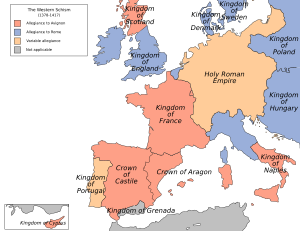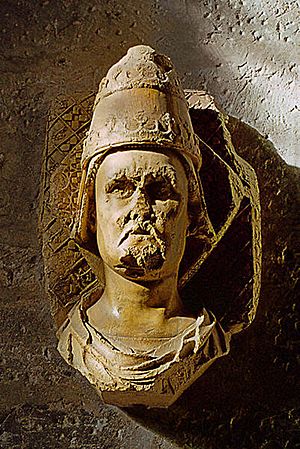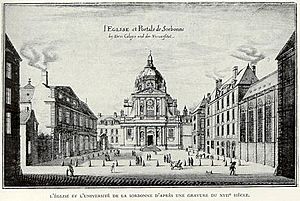Thomas de Rossy facts for kids
Quick facts for kids Thomas de Rossy |
|
|---|---|
| Bishop of Galloway | |
| Church | Roman Catholic Church |
| See | Diocese of Galloway |
| In Office | 1379–1397 x 1406 |
| Predecessor | Ingram de Ketenis |
| Successor | Elisaeus Adougan |
| Orders | |
| Consecration | before 16 July 1380 |
| Personal details | |
| Born | unknown Probably Scotland |
| Died | 1397 × 1406 |
Thomas de Rossy was a Scottish friar (a type of religious brother) from the Franciscan Order in the late 1300s. He was also a special helper to the Pope, a bishop, and a theologian (someone who studies religion). We don't know much about where he came from. He started his religious journey early, joining the Franciscans. He studied in England and at the famous University of Paris.
Thomas gave talks and lessons about the Immaculate Conception (a religious belief). He became important with help from the Avignon Papacy (a time when the Pope lived in Avignon, France) and King Robert II of Scotland. He became the Bishop of Galloway. He was the only Franciscan to become a bishop in Scotland. After this, he strongly supported Avignon Pope Clement VII. Clement was against Pope Urban VI, who was supported by England. Thomas preached and wrote fiercely for Clement. He even famously challenged any English bishop to a single combat (a one-on-one fight) to settle the issue!
Contents
Thomas's Early Life and Studies
We don't have many details about Thomas de Rossy's early life. His name suggests his family came from a place called Rossie. There are many places with this name in Scotland.
On October 3, 1371, he got special permission from the Pope. This was after King Charles V of France and King Robert II of Scotland asked for it. This permission allowed him to get his Bachelor of Theology degree at the University of Paris. This is the first time we see his name in official records.
This papal document tells us a bit more about his past. It said he was Scottish. He had joined the Order of the Friars Minor (Franciscans). He had also studied the Seven Liberal Arts and Theology in different places, including the University of Paris. He had also given sermons in Paris. Thomas likely went back to Scotland to preach and teach, which was common for Franciscans. Later, he said he studied in Paris and lived among English people for seven years. This helped him understand their ways.
Before Becoming a Bishop
In 1371, Thomas was at the Pope's court in Avignon. He was helping Patrick de Leuchars, who was the Bishop of Brechin. Thomas made a payment for him to the Pope's money office.
After getting his Theology degree, Thomas gave lectures in Paris in 1373. He spoke about the Immaculate Conception (a belief about Mary, the mother of Jesus). He had been chosen by the head of the university to give these summer lectures.
By 1375, Thomas was the main leader of the Franciscan Order in Scotland. He was running out of money. This made it hard for him to finish his studies. So, Pope Gregory XI wrote to Walter de Wardlaw, the Bishop of Glasgow. The Pope asked Walter and other scholars to give Thomas a Licentiate and a Doctorate in Theology if they thought he was ready. Getting these degrees would let Thomas teach legally. This would help him with his money problems.
Thomas was in Avignon again in 1375. But he returned to Scotland between March 1378 and April 1379. During this time, the Scottish King gave him £10 as a gift. By June 22, 1379, Thomas was back at the Pope's court in Avignon. While there, the newly chosen anti-Pope, Clement VII, gave him a special job. Thomas became a papal penitentiary for people who spoke English and Irish. This meant he could hear confessions and grant forgiveness for sins on behalf of the Pope.
Becoming the Bishop of Galloway


On July 15, 1379, Clement VII offered Thomas de Rossy the job of Bishop of Galloway. This was on one condition: if Ingram de Ketenis decided not to take the job. On the same day, Thomas and another Scot, Hugh de Dalmahon, were sent to Scotland. They carried 50 florins (a type of coin) and documents. These documents explained what led to the Western Schism. This was a big split in the Catholic Church. The documents claimed that the election of Pope Urban VI was not valid.
The position of Bishop of Galloway was open because Adam de Lanark had died. This happened when there was no Pope. Oswald, the head of Glenluce Abbey, was chosen by the priests of Whithorn Priory to replace Adam. Pope Urban VI supported Oswald's election. But Clement VII, who was supported by Scotland, did not. Instead, Clement chose Ingram de Ketenis. Ingram was a high-ranking priest from Dunkeld. However, Ingram did not want to be bishop and raised objections.
Ingram's refusal allowed Thomas de Rossy to become bishop. He was officially made bishop by July 16, 1380. Oswald tried to appeal to Clement, but Clement rejected his appeal. A letter to Thomas from October 29, 1381, confirmed this. Another letter was sent to other bishops. It told them to stop Oswald from claiming to be the true bishop. It also told them to make sure Thomas de Rossy had peaceful control of the bishopric. Oswald, however, continued to be active in England, which supported Urban VI.
Thomas Supports Clement
As Bishop of Galloway, Thomas remained a strong supporter of Clement. He spoke about Clement's cause to King Robert II in Dundee on February 2, 1380. Scotland, which supported Clement, even planned a military attack on England, which supported Urban. John Wyclif, a famous English religious reformer, said that a Scottish bishop was given permission to lead a "crusade" (a religious war) into England. This bishop was almost certainly Thomas de Rossy. Thomas gave sermons in areas near the English border. He tried to get people to support Clement. He also wrote a paper attacking Urban's cause and England's support for it.
No "crusade" ever happened. But around 1384, Thomas sent a letter to the bishops of England. The letter invited Henry le Despenser, the Bishop of Norwich, or any other English bishop, to have a debate with him. Thomas wrote that if they preferred, they could settle the matter for both countries through single combat. Henry le Despenser was likely chosen because he was known for liking to fight. He had led a short military trip into France in 1383. Even though Thomas was eager to fight another bishop, he had apparently refused a fight with an English priest. This was because the priest had a lower rank than him.
Thomas as Bishop of Galloway
Thomas was the first and only Franciscan to become a bishop in a Scottish area. We don't have many records of Thomas's daily activities as Bishop of Galloway. One official document still exists, dated July 16, 1381. It confirms a gift of the church of Buittle to Sweetheart Abbey. This document was issued in Kirkchrist, in the parish of Twynholm. The Pope (Clement) confirmed it on October 18, when Rossy was at the papal court. On December 31, Thomas gave Pope Clement VII a list of requests, and all of them were granted.
After King Robert II died in 1390, Bishop Thomas and other church leaders attended the new king's coronation. At Scone, on August 16, 1390, two days after Robert III of Scotland became king, Bishop Thomas gave a sermon. According to a writer named Wyntoun: "The Bishop of Galloway there, Thomas, (A great theologian he was), Made a sermon very pleasing, And fitting for the occasion."
His Death and Successor
Bishop Thomas was in Avignon again in the mid-1390s. Records show he handled some everyday business there. On September 10, 1395, he was given permission to manage his bishopric from afar, using a helper. We don't know if he ever returned to Scotland. His name last appears in records on September 6, 1397.
We don't know the exact date he died. But a new bishop, Elisaeus Adougan, was not appointed until May 28, 1406. This means Thomas could have died any time between 1397 and 1406.
As a friar and a bishop, Thomas could not have children. We don't know anything about his own family. However, he had a nephew for whom he got several special favors from the Pope.
Thomas's Religious Writings
Thomas de Rossy was known as a theologian, someone who studies religion. His writings that still exist mostly focus on political arguments. He wrote two papers that we still have, and probably at least two others that are lost.
His work called Quaestio de Conceptione Virginis Immaculatae repeated some of the arguments for the Immaculate Conception. These arguments were first made by Duns Scotus. It also argued against scholars who had written against this belief. These included Bernard of Clairvaux, Giles of Rome, Bonaventure, Richard Middleton, Facinus de Ast, Robert Cowton, Alexander of Hales, and Gregory of Rimini. Thomas's focus on the Immaculate Conception came from his time in Paris. He preached in its favor there. Some even think Thomas was the Franciscan friar in Paris who was known for being a bit disrespectful towards Saint Bernard.
Rossy's second work was called Tractatus Episcopi Candidae Casae de Regno Scotiae in Facto Schismatis contra Anglicos suos Vicinos. This was a defense of Clement VII. It also attacked the claim of "Bartolomeo of Bari" (who was Urban VI) to be the true Pope. It includes a long, detailed story of what happened before the Church split. This story was partly taken from a work by Cardinal Peter Flandrin. To explain why Clement was the rightful Pope, the Tractatus used many prophecies. These were especially prophecies said to be from Saint John of Bridlington. The letter Thomas sent to the English bishops was added to this Tractatus Episcopi work. In the Tractatus, he accused the English of supporting Urban only because they hated the French.



